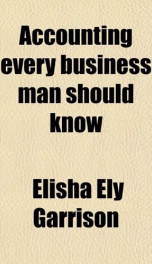accounting every business man should know

Purchase of this book includes free trial access to www.million-books.com where you can read more than a million books for free. This is an OCR edition with typos. Excerpt from book: CHAPTER VII VALUATION AND RESERVES WE have considered the bearing of the original entry in creating a correct record of values; we have also seen that it is unsafe to rely altogether upon the original entry as a means of maintaining that record. Some reasons have been given for the careful endeavour to have the ledger show true values. There is a great divergence in the opinions of sound and able business men on this question, many strongly advocating ruthless reduction of values. The advocates of the system of showing correct values urge the importance of this for insurance purposes, maintaining that it is safer, if it comes to dealing with adjusters, to be in a position to show the values carried on the ledger. A proper use of reserves for this purpose, instead of cutting down the account itself, makes it possible to show the valuesand at the same time derive all the benefits of the most strenuous measures for preventing too heavy a drain in the form of dividends. It tells the whole story of what has been done, which is a very great advantage, at least to those who have no motive for concealment. The creation of a reserve is very simple. For example, it has been decided to create a reserve of a certain percentage of the value of the buildings, i.e., to diminish the showing of the balance sheet by an amount which shall represent the supposed depreciation, or, regardless of depreciation, the desired reduction, in the volume of the account that purports to show the value of that investment. The old way is to make an entry at the end of the year exactly identical with that explained in connection with the creation of the balance sheet from the trial balance, where an inventory showed an account value incorrect. It is sometimes argued that this system does not remove the ...
Info about the book
Author:
Series:
Unknown
ISBN:
0986641006
Rating:
3/5 (2)Your rating:
0/5
Languge:
English
Users who have this book
Users who want this book
What readers are saying
What do you think? Write your own comment on this book!
write a commentif you like accounting every business man should know try:
Other books by this author
Do you want to read a book that interests you? It’s EASY!
Create an account and send a request for reading to other users on the Webpage of the book!


